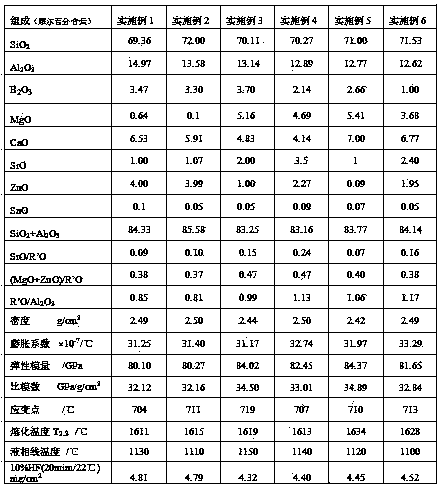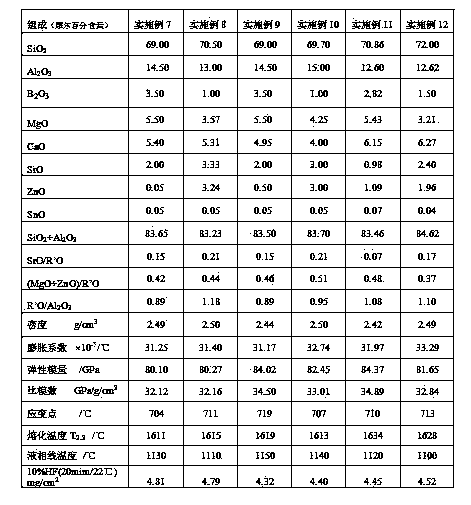Alkali-free glass
An alkali-free glass and glass technology, applied in the field of glass production, can solve the problems of toxicity, low glass bubble effectiveness, low temperature of clarified gas, etc., and achieve the effects of high chemical stability, lower production cost, and lower melting temperature.
- Summary
- Abstract
- Description
- Claims
- Application Information
AI Technical Summary
Problems solved by technology
Method used
Image
Examples
Embodiment Construction
[0028] A kind of alkali-free glass, the molar percentage of each chemical composition in the described glass is:
[0029] SiO 2 68.5-72%,
[0030] Al 2 o 3 12.6-15%,
[0031] B 2 o 3 1-3.7%,
[0032] MgO 0.1-5.5%,
[0033] CaO 4-7%,
[0034] ZnO 0.05-4%,
[0035] SrO 1-3.5%,
[0036] SnO 0.05-0.1%.
[0037] Preferably, SiO 2 with Al 2 o 3 The sum of the mole percentages is greater than 83%.
[0038] Preferably, SrO / (MgO+CaO+ZnO+SrO)<0.25.
[0039] Preferably, (MgO+ZnO) / (MgO+CaO+ZnO+SrO)>0.35.
[0040] Preferably, 0.82 o 3 <1.2.
[0041] Preferably, Al 2 o 3 The mole percentage of 13-14.5%.
[0042] Preferably, the molar percentage of ZnO is 0.5-3%.
[0043] preferred, B 2 o 3 The mole percentage of 1.5-3.5%.
[0044] Preferably, SiO 2 The mole percentage of 69-71%.
[0045] Preferably, the molar percentage of SrO is 1.5-3.0%.
[0046] During implementation, the raw materials including the corresponding oxide mole percent...
PUM
| Property | Measurement | Unit |
|---|---|---|
| strain point | aaaaa | aaaaa |
| thickness | aaaaa | aaaaa |
| strain point | aaaaa | aaaaa |
Abstract
Description
Claims
Application Information
 Login to View More
Login to View More - R&D
- Intellectual Property
- Life Sciences
- Materials
- Tech Scout
- Unparalleled Data Quality
- Higher Quality Content
- 60% Fewer Hallucinations
Browse by: Latest US Patents, China's latest patents, Technical Efficacy Thesaurus, Application Domain, Technology Topic, Popular Technical Reports.
© 2025 PatSnap. All rights reserved.Legal|Privacy policy|Modern Slavery Act Transparency Statement|Sitemap|About US| Contact US: help@patsnap.com


